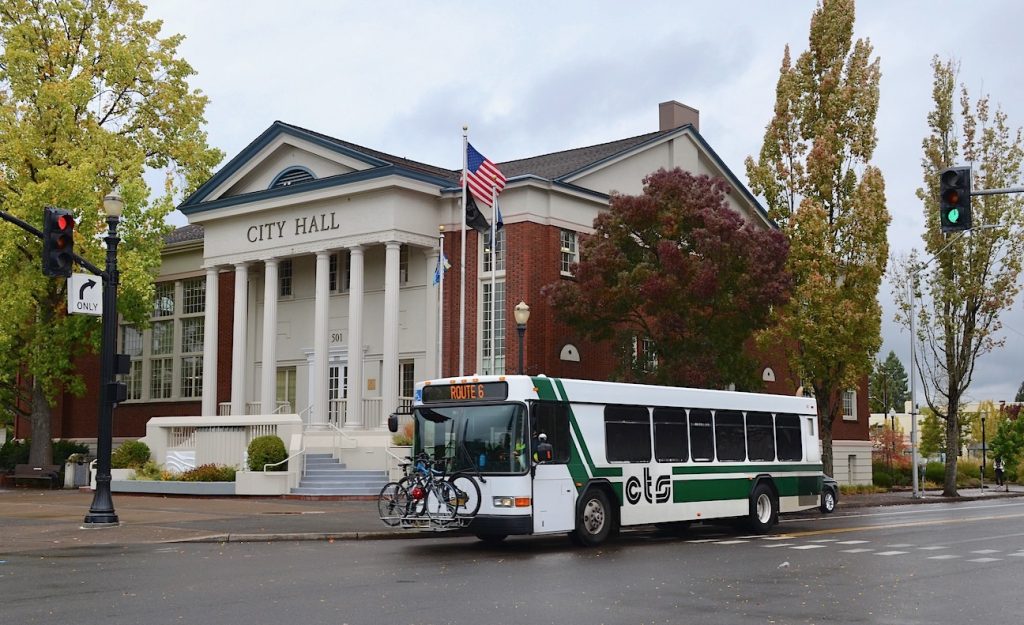
City Councilors will meet late this afternoon to discuss demolishing the current City Hall.
Built in 1924, the building still houses City staff and the Mayor’s office. However, the City Council’s chambers are located a few blocks away, atop the downtown fire station.
So the idea among officials has been to renovate the current City Hall to accommodate the City Council’s chambers, which would then be co-located with the Mayor’s office. Alongside that, they had envision constructing a larger building for City staff. The old and new buildings would then have been connected by a lobby.
City officials are also envisioning a new police station and municipal courts, and the desire is to co-locate all of this into a single campus.
Visions Change: The City hired FFA Architecture and Interiors to refine the plan, and in the firm’s view, a renovation would fall short of the city’s goals.
“The goal of the refinement effort is to determine if there are challenges to the viability of the concepts developed, to refine project designs, and to sharpen project cost estimates for the four projects. This work supports the development of a funding strategy to construct the new facilities,” according to a memo issued by City Manager Mark Shepard.
Also, according to Shepard, “As the evaluation and design refinement work progressed, FFA shared with staff that use of the existing City Hall structure would greatly limit the City’s ability to achieve the facility investment objectives in the project’s Guiding Principles and those gathered during the conversations with the Council, the public, and staff. Some objectives could be partially achieved, but the progress made toward the goals would fall far short of the level desired.”
Shepard’s memo states what staff sees as the negatives of renovating instead of building anew:
- Resiliency—Inability to achieve the target level of seismic performance (i.e., Seismic Design Category III or better) after an earthquake without destroying the integrity of the historic resource. Without this level of resiliency, the community would experience serious and long-lasting interruption to some services after an earthquake.
- Energy Efficiency—Inability to seal the building envelope, without destroying the integrity of the historic resource, to achieve the high energy-efficient performance that a new building will achieve.
- Accessibility—Inability to create a fair and equitable access for all due to the location of the building elevators and the spacing of the floors, requiring a separate and most likely rear-door entrance for persons with disabilities.
- Transparency—Inability to eliminate, without destroying the integrity of the historic resource, the existing building’s façade and the associated negative cultural cues it has for many residents, including patriarchy and authoritarianism, impeding the City Council’s desire to welcome diverse constituencies within the community into policy setting.
- Safety—Inability to create separate and secure spaces for the public and for Council/Judge/staff due to the location of the building elevators and restrooms.
- Stewardship—Inability to make the best long-term use of public funds because significant renovations to gut the interior are necessary to meet project objectives and the structural shell will remain, aged and deteriorating.
Shepard also cites what staff believes the positives would be with a completely new build:
- Accommodate all the desired City services in one place.
- Create a safe and secure environment for all building users with an appropriate separation between staff and public spaces.
- Deliver a civic building rated for ‘immediate occupancy’ after an earthquake.
- Take advantage of the new orientation on the block to maximize daylighting and reduce the energy needed to heat, cool, and light the interior.
- Provide street-level, equitable physical and cultural access points for community members and staff.
- Increase the amount of meeting room space for the public’s use to collaborate and interact with one another and City Councilors.
- Make City Council operations more transparent and inclusive.
- Provide a vibrant community space, an indoor/outdoor ‘living room’, for art and cultural events.
It’s Early Days: There is no budget yet for any of this, and it’s imaginable that discussion among City officials will go on for some time to come. Shepard posits the next steps would include public engagement – likely a number of outreach efforts, and certainly another public open house on the subject.
Fireworks Ban: The Council asked City staff to look into the possibility of a fireworks ban – staff is recommending against it.
“Enforcement of any type of ban in Corvallis would fall to the Corvallis Police Department (CPD). Enforcement of possession or lighting of fireworks is problematic. For reference, Eugene Police issued zero fines over the 2023 4th of July. A ban on the sale of fireworks will impact local businesses or nonprofits that rely on firework sales as annual fundraisers,” according to a memo to Council from Fire Chief Ben Janes.
Janes also said, “The City of Eugene’s ban prohibits lighting off fireworks. Eugene is covered by the Eugene/Springfield Fire District. Eugene enacted a fireworks ban and the City of Springfield does not have a ban on fireworks. So the experience in Eugene/Springfield is instructive.”
“In its first year of the ban, Eugene saw a measurable increase in fires from previous years. Conversely, the City of Springfield did not see an increase in the fires over the 4th of July. Therefore, the ban of fireworks in Eugene did not demonstrate a decrease in potential fire activity.”
Janes also notes. “While the Corvallis area experienced two fires during the 4th of July in 2023, neither were found to be attributed to fireworks. One fire was associated with farming equipment and the other was undetermined due to several possible ignition sources present in the area.”
And Now, We’ll Editorialize a Little: The memo cites no effort to gain viewpoints from the local canine population. We’re not saying their input should be decisive – we’re also not saying it shouldn’t be.
Do you have a story for The Advocate? Email editor@corvallisadvocate.com


